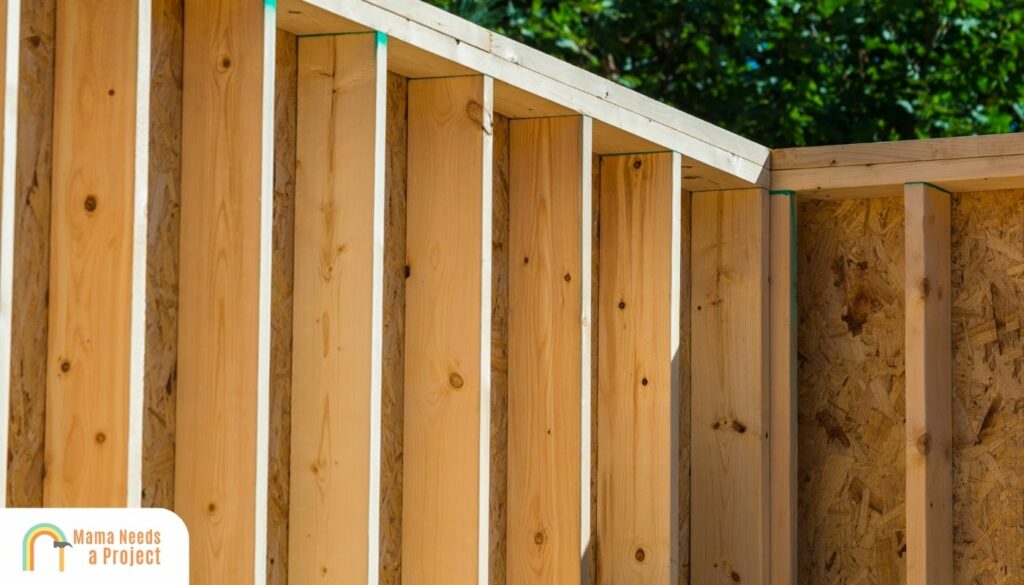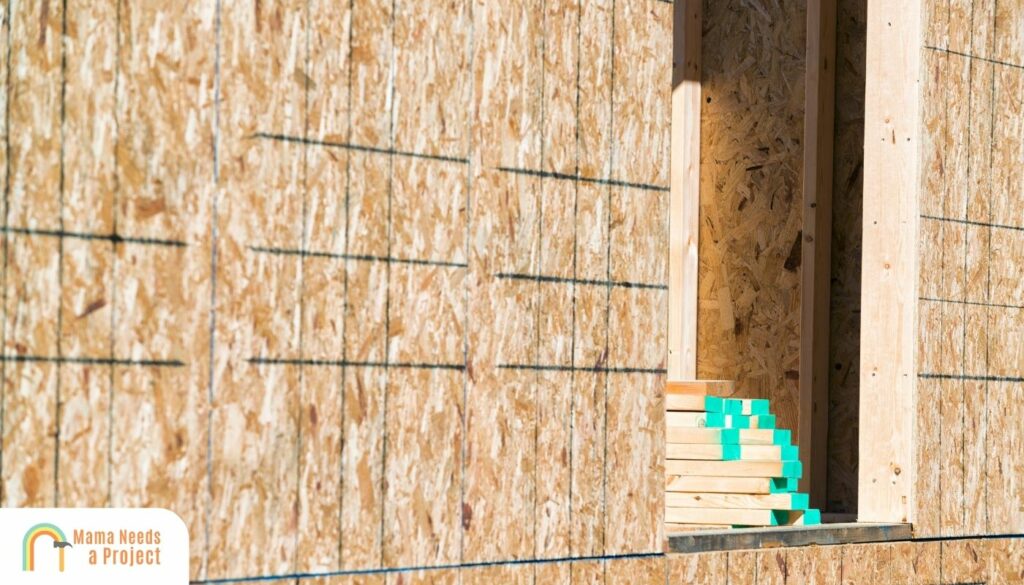How Much Weight can a 2×6 Hold? (Quick Answer!)
2x6s are used all the time in various building and home improvement projects, and they usually serve as joists, rafters, and other kinds of supports.
But before you start nailing 2x6s together, you need to know how much a 2×6 hold can in various positions, and these important points are exactly what I cover throughout this article. Let’s jump right in!
- On its edge, a 2×6 can support 53 lbs per linear foot before it starts to sag. Laid horizontally flat, a 2×6 can only support 4 lbs per linear foot. Vertically, a 2×6 can support 600-1,000 lbs. Lastly, most 2x6s have a span length between 12′ and 18′.
How Much Weight Can a 2×6 Hold Horizontally?
When a 2×6 is laid horizontally on its edge, it can support 53 lbs per linear foot, so long as it’s properly supported and blocked.
So, for example, an 8’ 2×6 can hold 424 lbs; anything more than that and the board would probably start to show signs of stress.
Therefore, technically speaking, horizontal 2x6s can support more than 53 lbs per linear foot, but once you go beyond that you run the risk of the board buckling from too much weight.
Now, when laid horizontally but flat, a 2×6 can’t support nearly as much weight—just 4 lbs per linear foot before signs of sagging may start to show.
So our 8’ board would only be able to support 32 lbs before it’s at risk of buckling.
But when a horizontal 2×6, whether it’s on its edge or flat, is supported from below, obviously it can hold more weight.
This is why you’ll see many decks with 2×6 surfaces. Because these boards are supported underneath by joists separated 24” apart, the amount of weight they can hold is far higher than 4 lbs per linear foot.
Wondering how this compares to a 2×4 or 4×4? Check out how much weight a 2×4 holds or how much weight a 4×4 holds!
How Much Weight Can a 2×6 Hold Vertically?

Assuming that each stud has been sheathed and blocked, a row of vertical 2x6s can support well over 7,000 lbs, so long as the studs are 16” apart.
A row of vertical, similarly spaced 2x4s, on the other hand, can only support about 1,000 lbs.
And if we’re talking about 2x6x8s, these can only support 525-1,000 lbs of load by themselves.
Sometimes, 2×6 studs are spaced 12″ apart, and other times they’re spaced 18″ apart. But most of the time, 2x6s are spaced 16″ apart.
Finally, if you want to increase the load-bearing capacity of vertical supports, ensure there’s less distance between them; just don’t go lower than 12″ apart.
Check out this guide to the actual size of a 2×4 and the actual size of a 2×6.
How Much Compressive Strength Does a 2×6 Have?
The amount of weight a 2×6 can support is different from its compressive strength.
Usually, when we’re talking about weight capacity, we’re talking about how much dead and live load a board, surface, etc. can bear.
But when we’re talking about compressive strength, we’re talking about the amount of force (pressure) a board, surface, etc. can take, and obviously both dead and live load play significant roles here.
So a beam may be strong enough to hold the constant weight of a piece of furniture but unable to withstand a person jumping up and down on it.
And just like load capacity, a board’s compressive strength is collectively determined by its grade, age, dimensions, and other factors.
How Much Weight Can a Pressure-Treated 2×6 Hold?

Many people assume that pressure-treated wood is stronger than natural wood, but this is only true in some respects.
Yes, pressure-treated wood resists moisture- and pest-related damage better than natural wood, but it’s weaker in terms of how much weight it can support, especially if incisions have been made so the chemicals can penetrate deeper.
But if you laid a 2×6 of natural wood next to a 2×6 of pressure-treated wood, and you put equal weight on both boards, you most likely wouldn’t see one sagging more than the other, and that’s because both boards can support up to 53 lbs per linear foot.
That said, when it comes to compressive strength, this is where natural wood has an edge—no pun intended!
You see, a 2×6 of natural wood can support 1097-1649 psi, whereas a pressure-treated 2×6 can only support 1097-1484 psi.
What Affects the Load Capacity of a 2×6?
Wood Species
Species is one of the most important factors to consider when determining how much weight a 2×6 can hold.
Various species—Douglas fir, spruce pine fir, southern pine—are stronger, and therefore they’re often used to make a building frame because they can support a significant amount of weight.
Woods like Siberian elm, cottonwood, and silver maple, on the other hand, aren’t the best for building because they hold much less weight and are more vulnerable to pests and moisture damage.
Generally, hardwoods can handle more load and span further than softwoods, but many softwoods, southern pine, are just as capable, if not more so.
Wood Grade
There are eight lumber grades, with Select Structural grade being the best and Utility grade being the worst.
Select Structural lumber supports the most weight capacity and has the longest span because it’s virtually free of the common defects you’ll find in lumber, i.e. knots, holes, and splits.
Number One grade, otherwise known as BTR lumber, is also great because it too has very few defects.
Number Two grade, which is used more than any other grade for framing, also has minimal defects.
Once you go below Number Two, load capacity and span decreases.
Dimensions
Dimensions are relevant too, mainly because the term 2×6 doesn’t necessarily refer to a board that’s 2″x6″.
In fact, most boards labeled 2×6 are actually 1.5″x 5.5″.
So if you come across a board that measures 2″x6″, it’s not technically a 2×6. But it will have slightly more dead load capacity and more span length than your standard 2×6, as it’s longer and thicker.
Grain Orientation
How the grain is oriented is important as well. Specifically, if the grain is relatively straight and uniform, the 2×6 beam should have greater dead load capacity and span length. An irregular grain, on the other hand, may make a board slightly weaker.
But more important than the grain itself is how weight and pressure are applied to it. If weight and pressure are applied parallel to the grain, the 2×6 board can support plenty. But if weight and pressure are going against the grain (perpendicular), the board won’t be able to support nearly as much.
Moisture Content
Generally, the more moisture content a 2×6 has, the less length it’ll be able to span.
Some wood species are naturally moist, and these species don’t make the best support joists because their high moisture content makes them more prone to buckling.
And if wood has become overly moist because it’s been exposed to days of non-stop rain or high humidity, it’ll eventually be unable to hold the weight it once could.
That’s why it’s so important to protect outdoor wood from moisture, as too much of it could compromise a whole structure, making it incredibly unreliable and unsafe.
Condition & Age
Obviously, wood that’s in poor condition cannot hold as much weight as it could when it was in better condition.
That said, you can’t make the mistake of thinking that all old wood is weak wood. In fact, wood that’s been cut from an old tree is actually some of the strongest wood you can get, whereas wood that comes off a new tree tends to be weaker.
Type & Location of Load
If load isn’t distributed equally across a 2×6, the board will be more prone to buckling. Also, if too much weight is concentrated on the center of the board, the likelihood that the board buckles goes way up.
How Far Can a 2×6 Span Without Sagging?
How far a 2×6 can span without sagging is in large part determined by how the 2×6 is being used. Put differently, 2x6s that are being used as floor joists can span further than 2x6s that are being used as deck joists.
Regarding how far a 2×6 can span before sagging, the International Residential Code (IRC) says the following:
- A 2×6 floor joist can span 12’-6” before sagging, while a 2×6 ceiling joist can span 20’-8”.
- A 2×6 rafter can span 18’ before sagging, while a deck board can span 24’.
- A deck joist can span 9′-11″ before sagging.
So why the difference? Well, if a beam is expected to hold more weight, it can only span so far.
So residential floor joists, for example, are expected to hold more weight because homes are often filled with multiple occupants and lots of furniture, and therefore they can only span about 12’.
But residential rafters can span much further, and that’s because they’re rarely burdened by a lot of weight, unless you live in an area where it snows heavily in the winter.
Are 2x6s Stronger Than 2x4s?
Vertical 2x6s and 2x6s that are laid on their edge are stronger than similarly placed 2x4s, but usually the difference in weight capacity isn’t significant.
Take framing, for example. Many homes are framed with 2x4s, but it’s totally fine to frame a house with 2x6s. In fact, 2x6s are actually preferred in colder climates, not because they’re stronger but because they’re better at insulating—this is largely a result of them being longer.
So unless local code requires 2x6s, you should have no problem framing with 2x4s. But if energy efficiency is a top priority of yours, a frame made of 2x6s will probably suit you better in the long run.
Is a 2×6 Stronger Than a 4×4?
4x4s are almost 100% stronger than 2x6s, but the key word here is almost. A 2×6 that’s laid on its edge will actually hold more weight than a 4×4.
So if you were to put 1,000 lbs of weight on a 2×6 spanning 72”, and then you put the same amount of weight on a 4×4 spanning the same distance, eventually you’d see the 4×4 sag. The 2×6, on the other hand, would be holding firm.
But vertically, a 4×4 has so much more weight capacity than a 2×6, and that’s mainly because they’re thicker and smaller. So while a 2×6 can support 600-1,000 lbs, a 4×4 can support up to 4,300 lbs—even if it’s 10’ tall! And if a 4×4 is on the shorter side, it can easily support upwards of 10,000 lbs.
And when laid flat horizontally, 4x4s can support more weight than 2x6s, again because of their thickness. But since these boards are rarely used horizontally, their flat weight capacity is slightly irrelevant.
Can Three 2x6s Support as Much Weight as a 6×6?
Many people assume that three 2x6s can support as much weight as a 6×6, but let’s examine this closely to see if that’s actually the case.
The most important point to consider here is wholeness. See, a 6×6 is one piece of wood, just as a 2×6 is a whole piece of wood. But if you glue, nail, or screw three 2x6s together, you can’t deem this end result a whole board, since three pieces of wood needed to be joined to make it.
Now, is the difference here really all that significant? Very! A whole 6×6 can support substantial weight because it’s one solid object. The joined 2x6s, on the other hand, are only as strong as the bonds that keep them together.
So if one section of the multi-piece board goes down, it’s only a matter of time before the remaining sections follow. You don’t have to worry about this as much with solid beams since they’re far better at distributing weight, even when live load has been poorly distributed above.
Are Two 2x6s Stronger Than a 4×6?
Since three 2x6s aren’t as strong as a solid 6×6, it should come as no surprise that two 2x6s aren’t as strong as a solid 4×6.
That said, there’s less of a gap here in terms of structural support provided, and that’s because there’s only one point at which the two 2x6s are joined.
But we must always remember that many factors collectively determine how much weight boards can support, and in some cases you can have joined boards that are stronger than a solid board because the latter is older and therefore only able to handle less weight.
Do Kiln-Dried 2x6s Support More Weight Than Naturally Aged 2x6s?
Yes, kiln-dried 2x6s offer greater support than naturally aged 2x6s, and that’s because super-heating wood in a kiln makes it stronger.
On the other hand, when lumber comes from a relatively young tree, it tends to be softer and weaker, no matter what kind of species it is.
So it should come as no surprise that virtually all wood supports used in home construction—from the frame to the floor joists—are made of kiln-dried lumber.
And along with being able to support a significant amount of weight, it can also withstand the numerous elements that erode natural wood over time.
Are you wondering what screws to use in your 2×6? Check out the video below!
Final Thoughts
To recap, a 2×6 that’s laid horizontal on its edge can support up to 53 lbs per linear foot before it starts to sag, and just 4 lbs per linear foot when it’s laid flat horizontally.
But when vertical, a 2×6 can support 525-1,000 lbs.
Finally, a variety of factors determine a 2×6’s weight capacity and maximum span, including species, grade, condition, and type of load.

